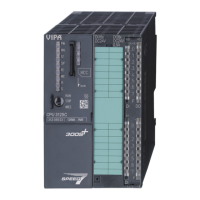n Number of Memory bytes from MB0: Enter the number of retentive
memory bytes from memory byte 0 onwards.
n Number of S7 Timers from T0: Enter the number of retentive S7
timers from T0 onwards. Each S7 timer occupies 2bytes.
n Number of S7 Counters from C0: Enter the number of retentive S7
counter from C0 onwards.
n Areas: This parameter is not supported.
n Priority: Here the priorities are displayed, according to which the
hardware interrupt OBs are processed (hardware interrupt, time-
delay interrupt, async. error interrupts).
n Priority: The priority may not be modified.
n Active: Activate the check box of the time-of-day interrupt OBs if
these are to be automatically started on complete restart.
n Execution: Select how often the interrupts are to be triggered.
Intervals ranging from every minute to yearly are available. The
intervals apply to the settings made for start date and time.
n Start date/time: Enter date and time of the first execution of the
time-of-day interrupt.
n Process image partition: This parameter is not supported.
n Priority: Here the priorities may be specified according to which
the corresponding cyclic interrupt is processed. With priority "0"
the corresponding interrupt is deactivated.
n Execution: Enter the time intervals in ms, in which the watchdog
interrupt OBs should be processed. The start time for the clock is
when the operating mode switch is moved from STOP to RUN.
n Phase offset: Enter the delay time in ms for current execution for
the watch dog interrupt. This should be performed if several
watchdog interrupts are enabled. Phase offset allows to distribute
processing time for watchdog interrupts across the cycle.
n Process image partition: This parameter is not supported.
n Level of protection: Here 1 of 3 protection levels may be set to
protect the CPU from unauthorized access.
– Protection level 1 (default setting):
No password adjustable, no restrictions
– Protection level 2 with password:
Authorized users: read and write access
Unauthorized user: read access only
– Protection level 3:
Authorized users: read and write access
Unauthorized user: no read and write access
5.9 Project transfer
There are the following possibilities for project transfer into the CPU:
n Transfer via MPI
n Transfer via Ethernet
n Transfer via MMC
Retentive Memory
Interrupts
Time-of-day interrupts
Cyclic interrupts
Protection
Overview
VIPA System 300SDeployment CPU 312-5BE13
Project transfer
HB140 | CPU-SC | 312-5BE13 | GB | 15-50 54

